Keywords: second-generation wavelet transform, lossless compression, SPIHT, medical images
1 Introduction With the development of society and the advancement of medical technology, people are more and more concerned about their health. Medical imaging is no longer information for doctors' reference only and has become an important basis for diagnosing diseases. Image compression coding under the condition of network transmission has become the key technology for establishing digital hospitals. At present, the compression standards for two-dimensional images include JPEG, GIF and JPEG2000 using wavelet transform. Medical images are special, and they generally do not allow the loss of useful details. The traditional DCT (Discrete Cosine Transform, discrete cosine transform) and the first generation wavelet will produce floating-point numbers after the image transformation, so the transformed data must be quantized, which will produce different degrees of distortion. It can be seen that the design of the quantizer is the key link that determines the image fidelity. Since the second-generation wavelet adopts the lifting method to realize the integer transform, it can realize the lossless compression of the image. Obviously, it is a compression method very suitable for medical images.
2 SPIHT algorithm Set ParTITIoning in Hierarchical Trees (SPIHT) based on hierarchical tree improves the embedded zero tree coding algorithm (EZW). After the wavelet transform is performed on the image, it more effectively utilizes the similarity between the important coefficients of sub-bands of different scales. It exhibits good characteristics: it constructs wavelets in the spatial domain without relying on the Fourier transform; a high PSNR (Peak Signal Noise RaTIo) guarantees a good quality of the reproduced image; integer arithmetic facilitates real-time rapid editing Decoding and network transmission; the gradual presentation of the image code stream is convenient for users to retrieve images of interest on the Internet.
The SPIHT algorithm uses the following coding steps for image information.
First, define three cohorts: insignificance coefficient queue LIP, saliency coefficient queue LSP, and insignificance set queue LIS.
Let O (i, j) denote the set of direct nodes of node (i, j); D (i, j) denote the set of child nodes of node (i, j); L (i, j) denote the exclusion of child nodes The collection after the direct node.
In the queue, each element is uniquely identified by a coordinate. It represents the isolation coefficient (root node without child nodes) in LIP and LSP, and D (i, j) or the second type of the first type element in LIS. L (i, j) of the element.
Significance test for a certain threshold T. Move elements greater than T into the LSP and remove the element in the LIP queue. The same test was performed on LIS, moving significant elements into the LSP, and then splitting the tree. 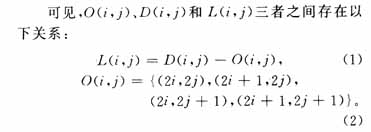
The SPIHT algorithm described in C ++-like language is as follows:
In the first step, the threshold T and the three queues (LSP, LIS, and LIP) are initialized. 
coordinate of; 
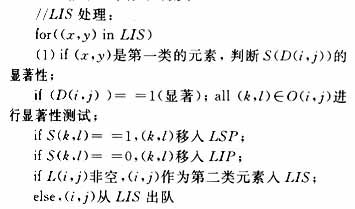
(2) if (x, y) is the second type of element, the significance test for L (i, j) if (L (i, j)) = = 1 all (k, l) ∈ O (i, j ) Move into LIS as the first type of element, and leave the team from LIS.
The third step is bit transmission / storage. Convert each coefficient in LSP into binary transmission / storage.
In the fourth step, the threshold value is updated and goes to the second step: T / = 2; gotostep2.
3 Lifting scheme and second-generation wavelet lifting method The construction of wavelet is divided into three steps: splitting, predicting and updating.
3.1 Split
Divide an original signal sequence Sj into two smaller, disjoint wavelet subsets Sj-1 and dj-1 according to even and odd numbers: ![]()
3.2 Prediction (predict)
Due to the correlation between the data, a prediction operator P can be defined so that dj-1 = P (Sj-1), so that adjacent even sequences can be used to predict odd sequences. If the difference between dj-1 and P (Sj-1) is used to replace dj-1, the data volume is much smaller than the original dj-1. ![]()
In the simplest case, the average value of the data of two adjacent even serial numbers is taken as the predicted value of the data of the odd serial numbers between them. which is, ![]()
3.3 Update
Since the above two processes generally cannot maintain some of the overall properties (such as brightness) in the original image, for this reason, we have to construct a U operator to update Sj-1 so that it maintains some characteristics of the original data set. 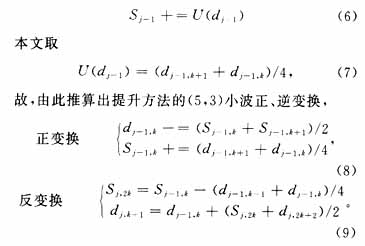
4 Encoding / decoding scheme In this paper, the front-end uses the second generation wavelet (lifTIng wavelet), then uses the SPIHT algorithm for the wavelet coefficients, and then uses Amir Said's adaptive arithmetic coding. Decoding is the inverse process of encoding, which includes three steps corresponding to forward SPIHT: recovery update, recovery prediction, and merge. The encoding / decoding scheme is shown in Figure 1.
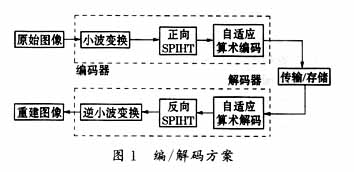
If the front end uses the first generation wavelet for lossy compression, a higher compression ratio can be achieved. Obviously, the requirements of high fidelity and high compression ratio for data compression in the second generation wavelet transform are contradictory.
5. Experimental results and conclusions For the previous coding scheme, we tested the medical image and the Lena image separately, and the bit rate bbp used bit / pixel. Because of the lossless compression scheme, the three different encoding methods in Table 1 all have PSNR = ∞.

Further analysis shows that, compared with the currently widely used JPEG, this compression scheme occupies less memory, has a high coding efficiency, and has no mosaic phenomenon. At low bit rates, the gap between the two is even more pronounced. If the scheme is implemented with parallel fast algorithms and hardware, its real-time performance will be further improved, so this medical image compression scheme has better application prospects.

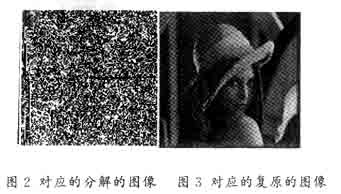
2 Erik Sjoblom. Compression of Medical Image Stacks Using Wavelets and Zero-Tree Coding. [Master Thesis]. Linkoping: Linkoping University, 2002
3 Xu Peixia. Wavelet analysis and application examples. Hefei: China University of Science and Technology Press, 2001
4 Chen Wufan. Wavelet analysis and its application in image processing. Beijing: Science Press, 2002
5 Hu Xuelong, Jiang Nan, Guo Zhenmin. Digital hospital image archiving and communication system (PACS). Journal of Engineering Graphics, 2001 (increasing)
6 Luo Wenbin, Zhang Liming. The application of the second generation wavelet in lossless compression of medical images. Computer Engineering, 1999 (10)
7 Tang Yan, Mo Yulong. The second generation wavelet transform is applied to lossless compression coding of images. Journal of Graphics and Images of China, 2000 (8)
The PufangTech VHF wireless modems operate in 147MHz to 174MHz and 220 to 230MHz frequency band. They can cover a range of 1 to 10Km through buildings and up to 50Km line of sight. It transmits and receives half duplex serial data at interface baud rates of 1200bps to 115200bps with narrow band digital frequency modulation.
The wireless modem can operate either as point to point or point to multi-point system. The configuration menu is a Windows based program running on PC.
These VHF wireless modems are low cost and rugged design which are easy to use with different transmission powers. Select the power level you need to punch through whatever distance within 50km and interference situations you encounter. PufangTech`s wireless modems are built to handle the heat, cold and environments of industrial operations.
VHF Wireless Modem,VHF Wireless Data Radio Modem,VHF Wireless Radio Modem,VHF Wireless Audio Modem
Shenzhen PuFang Technology Co., Ltd. , https://www.hytelus.com